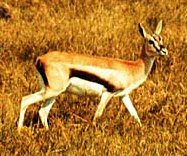Gazelles
|
|
| Gazelles | ||||||||||||
|---|---|---|---|---|---|---|---|---|---|---|---|---|
 Thomson's Gazelle | ||||||||||||
| Scientific classification | ||||||||||||
| ||||||||||||
| Species | ||||||||||||
|
Several, see text |
A gazelle is an antelope of the genus Gazella. Gazelles are known as swift animals; they are able to reach high speeds for long periods of time. Gazelles are mostly found in the grasslands and savannas of Africa, but also in south-west Asia. They tend to live in herds and will eat less coarse, easily digestable plants and leaves.
The gazelle species are classified as part of the order Artiodactyla, family Bovidae and genus Gazella. Members of the Articodacycla order are principally distinguished by the foot – they have an even number of toes (The bovid family includes 49 genera and 59 species.) The taxonomy of the genus Gazella is a confused one, and the classification of species and subspecies has been an unsettled issue. Currently, the genus Gazella is widely settled as containing 15 twelve valid species.
Three Species -- The Red Gazelle, the arabian gazelle and the Queen of Sheba's gazelle -- are extinct. All other species are listed as endangered to varing degrees.
A recognizable example of the gazelle is Thomson's Gazelle (Gazella thomsonii), which is around 60 to 90 cm in height at the shoulder and is coloured brown and white with a distinguishing black stripe (as in the picture on the right). The males have long, often curved, horns. Tommies, as they are familiarly called, exhibit a distinctive behaviour of stotting (that is running slowly and jumping high before fleeing) when they are threatened by predators such as lions or cheetahs. This is a primary piece of evidence for the handicap theory advanced by Amotz Zahavi in the study of animal communication and behaviour.
